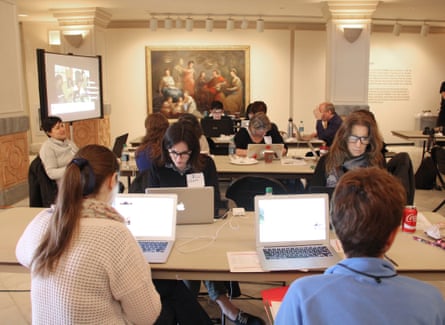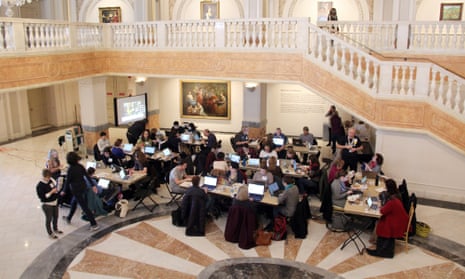There’s a better way to celebrate Women’s History Month than simply buying Hillary Clinton’s new book.
Those looking to improve the public record can volunteer a few hours at the fifth annual Wikipedia edit-a-thon at the National Museum of Women in the Arts in Washington DC, where one can create, edit and add to Wikipedia pages on women in the arts on 17 March.
“It’s for the promotion and establishment of art history,” said Sarah Osborne Bender, the museum’s library director. “We encourage gender equality in the arts and this is one way of doing it.”
Since the Wikipedia edit-a-thons started as informal gatherings in 2011, they have grown to 500 events worldwide where more than 7,000 volunteers have helped edit over 11,000 Wikipedia articles.
It’s all part of an initiative to improve the gender imbalance on Wikipedia, where reports have suggested less than 20% of contributors are women.
“Women haven’t felt as empowered to take the initial step of editing a Wikipedia article,” said Osborne Bender. “We train women, give them the tools and knowledge they need to create and edit articles, and stand by their edits, so it’s a community of support.”
The event is co-presented with Art+Feminism, a group founded in 2014 as a grassroots initiative run by artists, activists and programmers. Their goal is to improve the representation of women on Wikipedia and foster the editing community.
“We don’t just think about the impact of building awareness about the gender gap on Wikipedia in terms of what’s countable like article edits, but our greatest impact is modeling a form of defiance that kicks back at systems of misogyny and demands that they be dismantled,” said McKensie Mack, an Art+Feminism co-organizer.
This year’s theme is female art museum directors, curators and gallerists, helping raise the profile of female leadership roles in the art world and balance the gender gap.
Currently, the female art museum directors list on Wikipedia is incomplete. There is also an edit that questions the notability of these women. Edits that are made at these events are not always accepted on Wikipedia and they can spark online arguments.

“It can get aggressive,” said Osborne Bender. “I wrote a Wikipedia article about a woman gallerist and the next day, I got a message saying it was deleted because she is not a ‘noteworthy person’, but someone in our community gave me advice on how to edit it to make the page stay.”
The Wikimedia Foundation has also taken steps to reduce harassment by creating an anti-harassment team to mediate disagreements and protect people who are being attacked, especially new contributors to the site.
Before each session, Osborne Bender briefs volunteers on the ethics of editing. “I think it’s a mistake to see Wikipedia as a PR tool,” she said. “It’s the self-policing of the site, and you have the right to edit an entry to make something sound more neutral.”
While a Wikipedia-editing event for Women’s History Month is certainly a celebration, it’s hardly a party scenario. “The day starts chatty with a meet and greet, and as the day goes on, it gets real quiet,” said Osborne Bender. “People put on their headphones and settle in their zone. It’s a tough task writing Wikipedia articles from scratch, making sure you avoid plagiarism and distill large amounts of information into a digestible read.”
The vibe is like a university library a week before finals – quiet and tense. “It’s like writing a research paper in the public domain but in a marathon setting,” she said. “We have coffee and snacks.”
This Wikipedia edit-a-thon works similarly to the Black Lunch Table, which focuses on editing articles for black artists, as well as Wikiproject Women in Red, which adds articles about notable women who are missing from Wikipedia.
The edit-a-thon and its spin-offs have helped raise the proportion of biographies about women on the English language edition of Wikipedia from 15% to 17%.
“These events are beautiful because they are simple and effective; they are clear demonstration of the power of a committed collective of women and allies,” said Sehreen NoorAli, the founder of EdTechWomen, a community for women in technology. “Anything that tells a bigger, more accurate story about the contributions of women and minorities is essential at this historical moment because every concerted push is helping to overturn traditional structures of power to make a more equitable society.”
The edit-a-thon group has helped edit Wikipedia entries on Dorrit Black, an Australian landscape painter from the 20th century; the New York feminist painter Joan Semmel; the artist Judy Chicago; and the art critic Lucy Lippard, among others.
“I love training women to use this public platform and assert their own issues of visibility and imbalance in the arts,” said Osborne Bender. “We get a lot of women attending this event and I love to see that after they spend the day with us, they feel they can do this on their own.”
